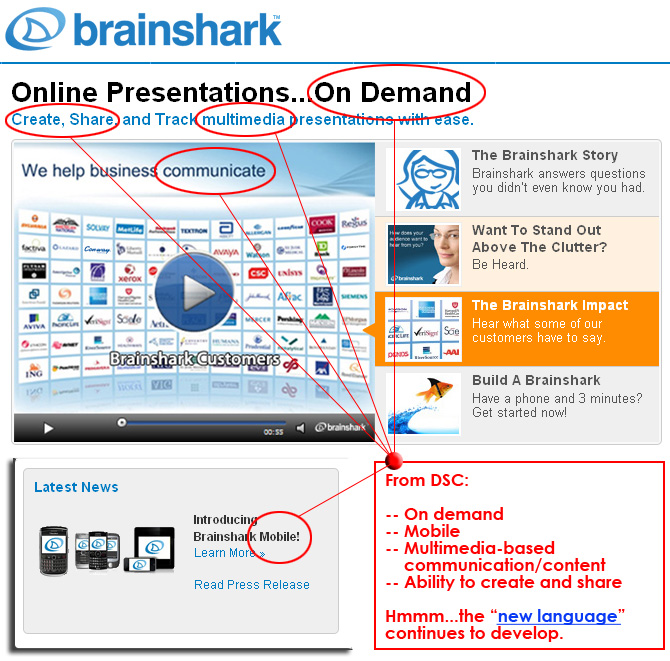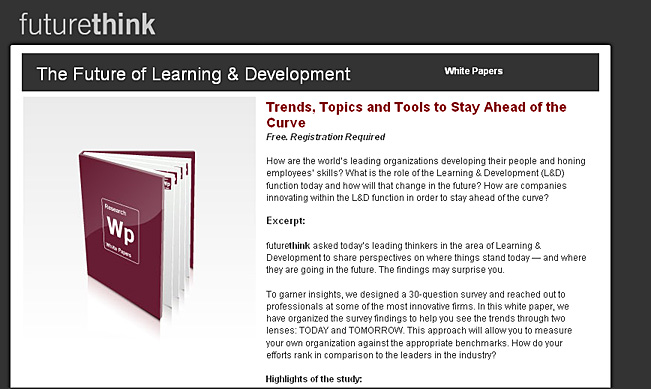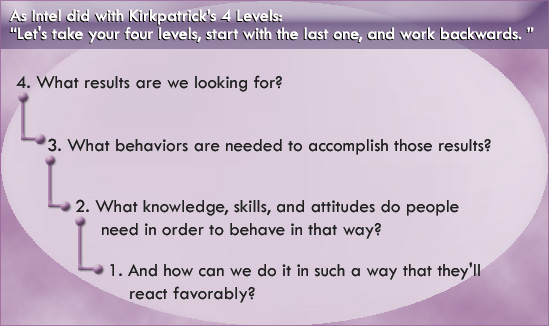Highlights of the study:
- 74% see the influence of L&D expanding in the immediate future (0-2 years)
- Almost 50% believe their training offerings will grow in the next two years
- Online learning is set to take center stage, with eLearning (62% will offer it), collaborative training (62%) and webinars (55%) being the formats identified as necessary for success
- 85% agreed/strongly agreed that the majority of learning will be collaborative going forward
- 100% agreed/strongly agreed that learning in the future will be done in short timeframes, using ‘micro modules’ to provide more focused learning and achieve better results
Book Review: Ruth Clark’s Evidence-Based Training Methods — by Cammy Bean
 My latest review: Ruth Clark’s Evidence-Based Training Methods: A Guide for Training Professionals.
My latest review: Ruth Clark’s Evidence-Based Training Methods: A Guide for Training Professionals.
Recommendation: Thumbs Up.
I presented a webinar today and found myself quoting liberally from this book. So if that’s not a good indicator of its usefulness, I don’t know what is!
Excerpt from Cammy Bean’s recap of ASTD 2010
Moodle
On the stand, we had lots of interest in our corporate Moodle LMS offering. I’ve asked before whether the corporate Moodle is at a tipping point, and the strong indicators are, yes. Yes, indeed.
Companies want the flexibility and freedom of an open source model. People are frustrated with ongoing licensing fees, lack of good customer support and responsiveness from traditional LMS vendors, and slow time to implement.
I heard a lot of, “I’ve been looking into Moodle and we’re really interested…tell me more.” (If you want to know more, be sure to read some of the case studies on the work we’ve been doing in the corporate Moodle space).
5 Stages of Workplace Learning — from Jane Hart
I interrupt my series of postings on Collaboration Platforms, to talk a little about the stages of Workplace Learnng
As I have read the comments on my recent postings as well as tweets and postings on other blogs, I’ve identified what I think are 5 main stages of workplace learning. I’ve tried to capture these, in a very rough and ready way, in the diagram below.
…
But some of the key mindset changes that will move organisations into Stage 5 are:
- recognising that working=learning; learning=working
- understanding that informal learning needs to be enabled, supported and encouraged – but not designed or managed
- “letting go”, so that there is a move from learner control to learner autonomy
- realising that autonomous, independent and inter-dependent, self-directed learners are essential in an agile organisation
Why America needs to start educating its workforce again — Techcrunch.com [via George Siemens]
From DSC:
This article/topic reminded me of a reading from Drucker (2004, p. 27):
“People change over such a long time span. They become different persons with different needs, different abilities, different perspectives, and therefore, with a need to “reinvent themselves.” I quite intentionally use a stronger word than ‘revitalize.’ If you talk of fifty years of working life — and this, I think, is going to be increasingly the norm — you have to reinvent yourself.”
Drucker, P. (2004). The Daily Drucker. HarperBusiness, New York.
Cisco WebEx facilitates training through web conferencing — from Cisco WebEx
Bangalore, Karnataka, India, Wednesday, March 24, 2010 — (Business Wire India)
Web conferencing and its functionalities
“Though collaboration technology is still not known by the masses, it has made inroads into several sectors including construction, manufacturing, hitech, retail, healthcare, pharma and education.” Says Kiran Datar, Managing Director, Cisco WebEx.
Web Conferencing facilitates the inter-department communication, dealer meetings and vendor interactions. It is effective in creating team workspaces with adequate authentication and security mechanisms, enforcing policies, giving the data complete security. Developers can enjoy the flexibility to rollout applications quickly and customers can enjoy the freedom to choose from multiple vendors.
This tool is used from product development to marketing, resulting in shorterturn-around time for completion of the product design cycle, supply chain and off shoring. Web conferencing is extensively used for multi-party audio, data sharing, synchronous video conferencing, application sharing, dynamic power point presentation sharing and file sharing.
Whether it is to increase sales effectiveness, enhance customer support, better communication with partners or permit employees to effectively coordinate their work with colleagues, web conferencing can produce tangible benefits and measurable results. It is for these reasons that a significant portion of large enterprises have adopted web conferencing and a growing number of smaller businesses are following suit. Web conferencing is a perfect way to cost-effectively deliver presentations, product demonstrations, meetings, seminars and training in today’s increasingly virtual workplace
Importance of web conferencing in training
Training is always a hot topic for debate and many companies usually defer training unless absolutely necessary because of various issues associated with it. Today many companies are looking for efficient ways to train more people at lower costs. This is where Web conferencing comes in. This technology makes it a joy for companies to train their employees.
There are many advantages a company could enjoy by embracing Web conferencing, some of which are mentioned below
• Savings through travel costs
• Involve more people in the same course
• Save time
• Scheduling becomes simpler
• Deliver custom made content
• Reinforcing learning through repetitions
From:
Learning TRENDS by Elliott Masie – March 19, 2010.
#612 – Updates on Learning, Business & Technology.
54,895 Readers – http://www.masie.com – The MASIE Center.
Host: Learning and Government – Special Forum in Washington, DC
Learning TRENDS by Elliott Masie – March 5, 2010.
#609 – Updates on Learning, Business & Technology.
54,891 Readers – http://www.masie.com – The MASIE Center.
Host: Virtual Leadership LAB & Seminar – Saratoga Springs
Google predicts demise of the desktop: John Herlihy, Google’s VP of Global Ad Operations, has claimed that desktop PCs would become “irrelevant” in three years down the line. Addressing the Digital Landscapes Conference in Dublin, Herlihy predicted a bleak future for desktop PCs, as smartphones, netbooks, along with other gadgets are evidently gaining grounds over them. In his keynote speech, Herlihy said: “In three years time, desktops will be irrelevant. In Japan, most research is done today on smart phones, not PCs”. This echoes Google CEO Eric Schmidt’s comments Global sales of smartphones and other high-end handheld devices have been soaring at a rapid pace and would very soon surpass sales of traditional PCs.” This has huge implications for the learning field – as we look towards supporting learning through a new and broader range of mobile based resources. Learning designers will need to refocus their design sensibilities towards a smaller footprint and very different type of learning application (emphasis DSC).
















